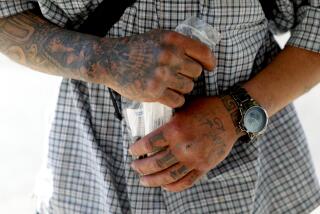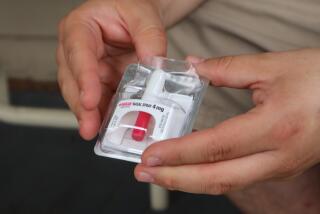Supply of Radiation Pills to Be Tripled
- Share via
State health officials have decided to more than triple the number of potassium iodide pills they distribute in communities around California’s two nuclear power plants.
The decision comes after health experts and residents near the San Onofre and Diablo Canyon nuclear generation stations expressed concern that there might not be enough of the medication for the people who live, work, attend school and vacation in those areas. The pills could reduce the effects of radiation poisoning after an accidental radiation release or act of terrorism.
At least 400,000 of the 1.4 million pills will be given to residents within a 10-mile radius of the plants, which are in Orange County and San Luis Obispo County. But now, the state officials say they will also make pills available to worried residents who live outside the zones and to people who pass through the areas.
“I think we want to be better safe than sorry,” said Eric Lamoureux, spokesman for the Governor’s Office of Emergency Services.
The state’s decision won support from some health activists, who have been pushing for a wider distribution of the pills.
“It’s exciting,” said Jonathan Parfrey, director of the Southern California chapter of Physicians for Social Responsibility. “I hope this is a very popular program.”
Potassium iodide, also known as KI from abbreviations on the periodic table of elements, is a form of salt that protects against one type of radioactive isotope: that of iodine. The pills help block the absorption of radioactive iodine by the thyroid, reducing the chance of thyroid cancer, the most common ailment suffered after the 1986 Chernobyl nuclear plant explosion in Ukraine.
A few months after the terrorist attacks on the World Trade Center and Pentagon in 2001, the federal Nuclear Regulatory Commission offered the pills to more than 4 million people who live within the 10-mile evacuation zones of nuclear power plants across the nation. California was one of the states that signed up for a supply and received 400,000 doses in the summer.
But the state has been struggling to come up with a distribution plan.
Originally, the state planned to make the pills available only to those living in the 10-mile evacuation zones -- 421,000 residents near San Onofre and 22,000 residents near Diablo Canyon.
But officials debated whether the pills should be given directly to residents or stored at public facilities such as schools and hospitals farther from the plants. Some argue that giving the pills to residents might offer them a false sense of security and make them reluctant to get out of the area in the event of an accident or attack. On the other hand, some officials question how realistic it was to expect that residents could get to the facility where the pills would be stockpiled.
There was also debate about how to protect vacationers, schoolchildren and commuters who don’t live in the zones.
In the end, the state decided to distribute the pills directly to residents in the zones and to anyone who requested them and also stockpile pills at some facilities. To address the concerns of residents outside the zones who felt they were being left out, the state is proposing to give the pills to anyone who requests them.
Distribution could begin within two months.
“We want to make sure -- just in case there’s a run on it, which we don’t expect -- that we can make it available not only for those people living in the area, but also working in the area and recreating in the area,” Lamoureux said. “Those numbers are hard to calculate. So having more than enough on hand, we believe, is prudent.”
San Clemente Mayor Stephanie Dorey, whose city is just north of San Onofre, said residents will be relieved to hear about the state’s plans.
She said she hopes the plan is implemented as soon as possible and paired with a comprehensive public awareness campaign.
“It’s about time. And this needs to be done post-haste,” she said, adding that with the nation focused on homeland security, “this is one of the most important things that needs to be handled on the home front. We’re vulnerable down here.”
More to Read
Sign up for Essential California
The most important California stories and recommendations in your inbox every morning.
You may occasionally receive promotional content from the Los Angeles Times.













